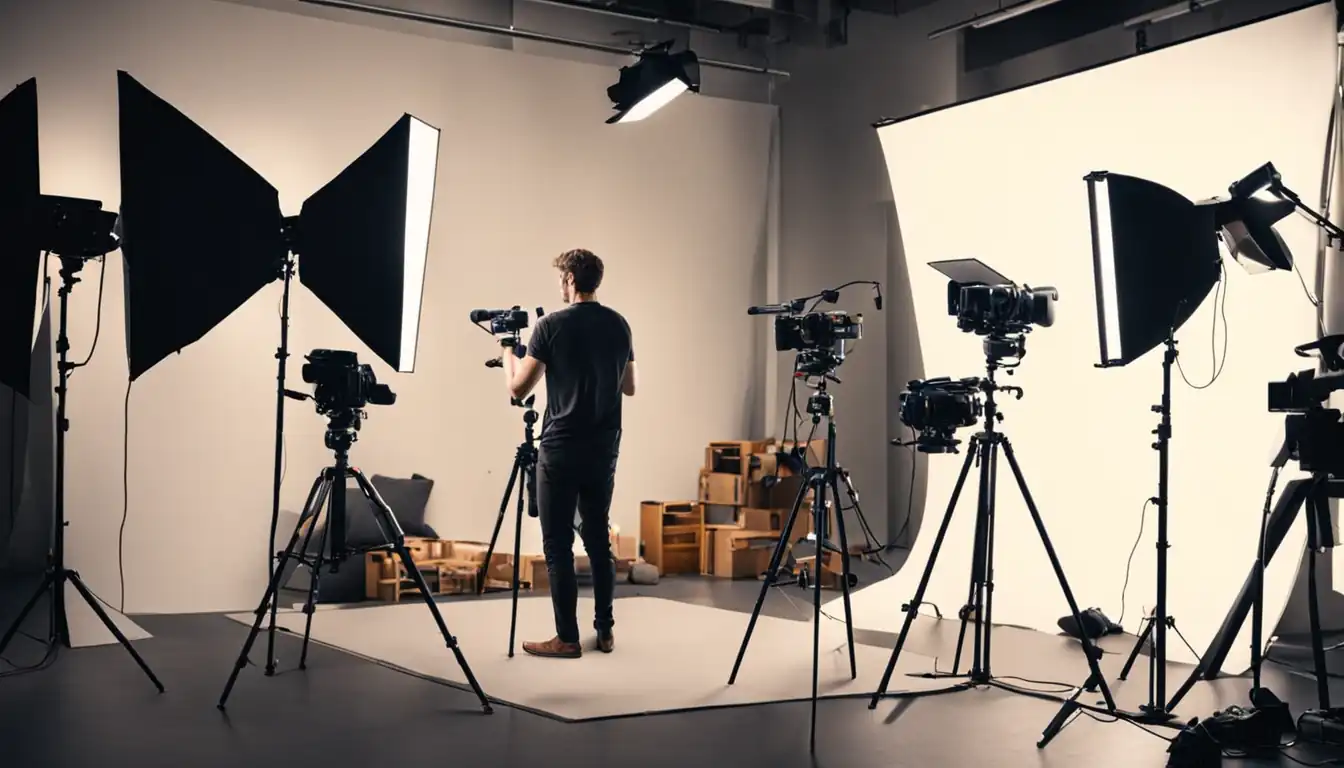Visual Content Creation for SEO

In the ever-evolving world of SEO, visual content has become a powerful tool for driving traffic and engagement to websites. From eye-catching images to informative infographics and engaging videos, incorporating visuals into your content strategy can significantly impact your site's search ranking. In this post, we will explore the importance of visual content creation for SEO and provide tips on how to optimize your visuals for maximum impact.
The Power of Images in Digital Marketing

Visual content plays a crucial role in digital marketing strategies, as it has the power to captivate audiences and convey messages effectively. Here are some key points highlighting the importance of images in digital marketing:
How visuals boost engagement and retention
- Visuals have the ability to grab attention quickly and engage users more effectively than text alone.
- Studies have shown that content with relevant images receives significantly more views and shares compared to text-only content.
- Visuals help in conveying complex information in a simple and digestible format, leading to better retention of information by the audience.
The SEO benefits of using high-quality images
- Search engines like Google prioritize websites that offer a good user experience, including visually appealing content.
- High-quality images can improve the overall aesthetics of a website, making it more attractive to visitors and reducing bounce rates.
- Image optimization techniques such as adding alt text, captions, and descriptive filenames can improve SEO by making images more discoverable in search engine results pages.
Incorporating visual content creation into your SEO strategy can significantly enhance your online presence and drive more traffic to your website.
Crafting the Perfect Image for SEO
Understanding image relevance and context
When creating visual content for SEO, it is crucial to understand the importance of image relevance and context. Search engines like Google use algorithms to analyze images based on their relevance to the surrounding content. This means that using images that are closely related to your topic can help improve your SEO ranking.
Additionally, consider the context in which the image will be used. Is it supporting a specific point in your article? Is it meant to evoke emotion or provide information? By understanding the purpose of your image, you can ensure that it enhances your overall content strategy and helps drive traffic to your site.
Optimizing file names and alt text for search engines
One often overlooked aspect of visual content creation for SEO is optimizing file names and alt text. When you upload an image to your website, make sure to give it a descriptive file name that includes relevant keywords. This not only helps search engines understand what the image is about but also improves accessibility for visually impaired users who rely on screen readers.
In addition to file names, alt text plays a crucial role in SEO. Alt text provides a textual description of an image, which search engines can use to index and rank your content. Be sure to include relevant keywords in your alt text while accurately describing the image. This will not only improve your SEO but also enhance user experience for all visitors to your site.
Leveraging Infographics for Enhanced SEO Performance
Infographics are powerful visual tools that can significantly boost your SEO performance. When done right, infographics can attract backlinks, increase social shares, and improve overall website traffic. Here are some key points to consider when leveraging infographics for SEO:
The anatomy of an effective infographic
Clear and Concise Information: An effective infographic should convey information in a clear and concise manner. Avoid cluttering the design with too much text or visuals.
Eye-catching Design: Use vibrant colors, engaging visuals, and attractive fonts to make your infographic visually appealing.
Relevant Data: Ensure that the data presented in the infographic is accurate, up-to-date, and relevant to your target audience.
Branding Elements: Incorporate your brand logo, colors, and other branding elements to maintain consistency across all your visual content.
Call-to-Action: Include a call-to-action at the end of the infographic to encourage viewers to take the desired action, such as visiting your website or sharing the infographic on social media.
Tips for making your infographics shareable and SEO-friendly
Optimize for Search Engines: Use relevant keywords in the title, alt text, and description of the infographic to improve its visibility on search engines.
Include Social Sharing Buttons: Make it easy for viewers to share your infographic by including social sharing buttons on your website or directly within the infographic itself.
Promote Across Multiple Channels: Share your infographic on social media platforms, email newsletters, and other relevant channels to reach a wider audience.
Submit to Infographic Directories: Submitting your infographic to popular directories can help increase its visibility and attract more backlinks.
Track Performance: Monitor the performance of your infographics using analytics tools to see how they are contributing to your overall SEO strategy.
By following these tips and best practices, you can create visually appealing infographics that not only enhance user engagement but also drive valuable traffic to your website through improved SEO performance.
Video Content and Its Rising Importance in SEO Strategies

In today's digital landscape, video content has become an essential component of any successful SEO strategy. With the rise of platforms like YouTube and the increasing popularity of video content on social media, incorporating videos into your website can have a significant impact on your search engine rankings.
Why videos can dramatically improve your site's SEO
- Increased engagement: Videos are more engaging than text-based content, leading to longer dwell times and lower bounce rates.
- Improved user experience: Visual content is easier for users to consume and can help convey complex information more effectively.
- Higher visibility: Videos are more likely to appear in search results, especially on Google's universal search feature.
Best practices for video optimization on your website
- Keyword research: Just like with traditional SEO, it's important to conduct keyword research to optimize your video titles, descriptions, and tags.
- Create high-quality content: Invest in creating visually appealing and informative videos that will keep viewers engaged.
- Optimize video metadata: Make sure to include relevant keywords in your video titles, descriptions, and tags to improve visibility.
- Use schema markup: Implementing schema markup for videos can help search engines better understand the content of your videos.
- Promote sharing: Encourage viewers to share your videos on social media platforms to increase visibility and drive traffic back to your website.
By incorporating video content into your SEO strategy and following best practices for optimization, you can improve your site's visibility in search results and attract more organic traffic.
Social Media Visuals and Their Impact on SEO

Visual content plays a crucial role in social media marketing, and its impact extends beyond just engagement metrics. When it comes to SEO, social media visuals can significantly contribute to your site's search ranking. Here are a few key ways in which social media visuals can benefit your SEO efforts:
How social media visuals contribute to your site's search ranking
Increased Engagement: Visual content tends to attract more attention and engagement on social media platforms compared to text-only posts. This increased engagement can lead to more shares, likes, and comments, which can ultimately drive traffic back to your website.
Backlinks: Compelling visual content has a higher chance of being shared by other websites or blogs, leading to valuable backlinks. Backlinks are an important factor in search engine algorithms and can help improve your site's authority and ranking.
Brand Visibility: Consistent use of visually appealing content on social media platforms can help increase brand visibility and recognition. When users see your brand's visuals across different platforms, they are more likely to remember and search for your website directly.
Improved Click-Through Rates (CTR): Eye-catching visuals in social media posts can entice users to click through to your website. Higher CTRs indicate relevance and quality to search engines, which can positively impact your site's SEO performance.
Strategies for optimizing visual content across social platforms
To maximize the SEO benefits of visual content on social media, consider implementing the following strategies:
Optimize Image Alt Text: Use descriptive alt text for images posted on social media platforms. Alt text helps search engines understand the context of an image, making it more likely to appear in relevant searches.
Consistent Branding: Maintain consistent branding elements such as colors, fonts, and logos across all visual content shared on social media platforms. This not only reinforces brand identity but also makes it easier for users to recognize and engage with your content.
Use High-Quality Images: Invest in high-quality images that are clear, relevant, and visually appealing. Low-quality images can reflect poorly on your brand and may deter users from engaging with your content or visiting your website.
Utilize Video Content: Incorporate video content into your social media strategy as videos tend to perform well in terms of engagement and shareability. Video content is also favored by search engines and can help improve your site's SEO performance.
By leveraging the power of visual content on social media platforms strategically, you can enhance your site's search ranking and drive organic traffic effectively.
Tools and Resources for Creating Stunning Visual Content
Visual content plays a crucial role in SEO, as it can significantly enhance user engagement and improve the overall user experience on your website. To create visually appealing content that resonates with your audience and boosts your SEO efforts, you need the right tools and resources at your disposal.
Must-have tools for beginners and professionals
Canva: Canva is a user-friendly design tool that offers a wide range of templates, graphics, and fonts to help you create stunning visual content without any design experience.
Adobe Creative Cloud: For more advanced users, Adobe Creative Cloud provides professional-grade software like Photoshop, Illustrator, and InDesign for creating high-quality visuals.
Piktochart: Piktochart is an excellent tool for creating infographics, presentations, and social media graphics with customizable templates and easy-to-use features.
Visme: Visme is another versatile platform that allows you to design interactive presentations, infographics, reports, and other visual content.
Unsplash: Unsplash offers a vast collection of high-quality stock photos that you can use for free in your visual content creation.
Free resources to elevate your visual content game
Pexels: Pexels is a great resource for free stock photos and videos that you can use in your visual content without worrying about copyright issues.
Freepik: Freepik provides a wide selection of vector graphics, illustrations, icons, and photos that you can incorporate into your designs to make them more visually appealing.
Google Fonts: Google Fonts offers a diverse library of web fonts that you can use to enhance the typography in your visual content and make it more engaging for readers.
Color Hunt: Color Hunt is a platform where you can discover beautiful color palettes for your visual content to ensure consistency and aesthetic appeal across all your designs.
By utilizing these must-have tools and free resources effectively, you can take your visual content creation to the next level and drive better results for SEO optimization.
Conclusion
In conclusion, visual content creation plays a crucial role in enhancing your website's SEO performance. By understanding the power of images, infographics, videos, and social media visuals, you can effectively boost engagement, retention, and search ranking. Utilizing the right tools and resources to create stunning visuals will not only elevate your content game but also drive more organic traffic to your site. So start incorporating visual content into your SEO strategy today and watch your website soar to new heights in search results!